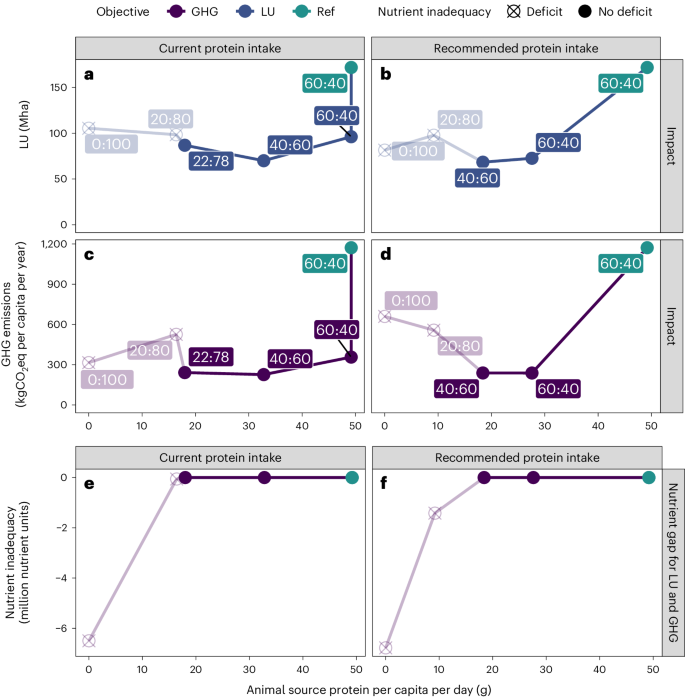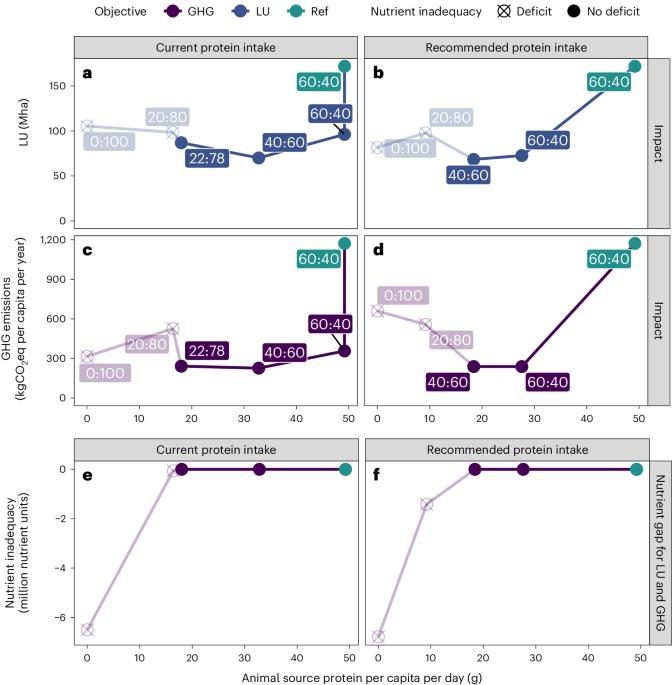Circular food system approaches can support current European protein intake levels while reducing land use and greenhouse gas emissions
IF 21.9
Q1 FOOD SCIENCE & TECHNOLOGY
引用次数: 0
Abstract
Protein transition and circular food system transition are two proposed strategies for supporting food system sustainability. Here we model animal-sourced protein to plant-sourced protein ratios within a European circular food system, finding that maintaining the current animal–plant protein share while redesigning the system with circular principles resulted in the largest relative reduction of 44% in land use and 70% in greenhouse gas (GHG) emissions compared with the current food system. Shifting from a 60:40 to a 40:60 ratio of animal-sourced proteins to plant-sourced proteins yielded a 60% reduction in land use and an 81% GHG emission reduction, while supporting nutritionally adequate diets. Differences between current and recommended total protein intake did not substantially impact minimal land use and GHG emissions. Micronutrient inadequacies occurred with less than 18 g animal protein per capita per day. Redesigning the food system varied depending on whether land use or GHG emissions were reduced—highlighting the need for a food system approach when designing policies to enhance human and planetary health. Almost half of land use and nearly three-quarters of greenhouse gas emissions can be reduced by adopting circularity principles and reducing the ratio of animal-sourced protein to plant-sourced protein from 60:40 to 40:60 in European diets.


循环食品系统方法可支持欧洲目前的蛋白质摄入水平,同时减少土地使用和温室气体排放
蛋白质转型和循环食品系统转型是支持食品系统可持续性的两种拟议战略。在这里,我们模拟了欧洲循环食品系统中动物源蛋白质与植物源蛋白质的比例,结果发现,与当前的食品系统相比,保持当前动物源蛋白质与植物源蛋白质的比例,同时按照循环原则重新设计系统,可以最大程度地减少 44% 的土地使用和 70% 的温室气体排放。将动物源蛋白质与植物源蛋白质的比例从 60:40 转变为 40:60,可减少 60% 的土地使用和 81% 的温室气体排放,同时支持营养充足的膳食。当前蛋白质总摄入量与推荐摄入量之间的差异并未对最小土地使用量和温室气体排放量产生重大影响。人均每日动物蛋白摄入量低于 18 克时,会出现微量营养素不足的情况。重新设计食物系统的方法因减少土地使用或温室气体排放而异--这突出表明,在设计提高人类和地球健康的政策时,需要采用食物系统方法。
本文章由计算机程序翻译,如有差异,请以英文原文为准。
求助全文
约1分钟内获得全文
求助全文

 求助内容:
求助内容: 应助结果提醒方式:
应助结果提醒方式:


